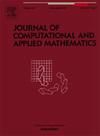一类鲁棒的多根最优四阶迭代格式及其应用
IF 2.1
2区 数学
Q1 MATHEMATICS, APPLIED
Journal of Computational and Applied Mathematics
Pub Date : 2025-05-21
DOI:10.1016/j.cam.2025.116758
引用次数: 0
摘要
本文旨在介绍和分析一类新颖的迭代方法,专门用于确保多根的鲁棒性和准确性逼近。这些方法来源于牛顿型迭代技术,具有高阶收敛性。利用权函数技术,所提出的方法在每个计算阶段只需要三个函数评估就可以实现四阶收敛。值得注意的是,在涉及不同多重根的情况下,所提出的族的理论收敛特性表现出对称特性。这种对称性促使结果的广义表示,证实了不同情况下的收敛顺序。此外,通过适当地选择自由参数,现有方法可以在这个更广泛的方法框架内作为具体实例获得。与传统方法相比,所提出的方法即使在所需根附近f ' (x)=0或f ' (x)→0时也能收敛。这一显著特征扩大了所提出方法的适用性,使它们能够处理传统方法由于临界点而失败的情况,例如f ' (x)=0的零点。本文通过对等熵超声速流动、Redlich-Kwong状态方程、连续搅拌槽式反应器、化学反应器分式转化和振荡问题等基准问题的大量数值实验来证实其观点。与几种已建立的算法的综合比较强调了所提出的方法在CPU效率和绝对残差最小化方面的优越性能。此外,为了验证理论和数值结果,我们利用不同的非线性方程,通过在复平面上绘制它们的吸引力盆地,将所提出的迭代方案与现有的几种迭代方案的收敛区域进行了比较和可视化。所提出的迭代方法在较短的时间内产生吸引子盆地,具有较宽的收敛区域,与以往已知的迭代方法相比,证实了其稳定性和优越性。本文章由计算机程序翻译,如有差异,请以英文原文为准。
A robust family of optimal fourth-order iteration schemes for multiple roots with applications
This article aims to introduce and analyze a novel class of iterative methods designed specifically to ensure robust and accurate approximation of multiple roots. These methods are derived from Newton-type iterative techniques and are characterized by their higher-order convergence properties. Utilizing the weight function technique, the proposed methods require just three functional evaluations per computation stage to achieve fourth-order convergence. Notably, the theoretical convergence characteristics of the proposed family exhibit symmetrical properties in scenarios involving roots with varying multiplicities. This symmetry motivates a generalized presentation of results confirming the convergence order across different cases. Furthermore, by appropriately selecting free parameters, existing methods can be obtained as specific instances within this broader methodological framework. In contrast to traditional methods, the proposed methods are capable of converging even when or near the required root. This notable characteristic broadens the proposed methods’ applicability, enabling them to handle cases where the traditional approaches fail due to the critical points, like the zeros of . The article substantiates its claims through extensive numerical experiments on diverse benchmark problems including the isentropic supersonic flow, Redlich–Kwong equation of state, continuous stirred tank reactor, fractional conversion in a chemical reactor and oscillation problem. Comprehensive comparisons with several established algorithms underscore the superior performance of proposed methods in respect of both CPU efficiency and minimization of absolute residual errors. In addition, to validate the theoretical and numerical results, we compare and visualize the convergence regions of the presented iteration schemes with several existing iteration schemes using diverse nonlinear equations by plotting their basins of attraction in complex plane. The presented iteration methods produce attractor basins in shorter time and exhibit broader convergence regions which confirm their stability and superiority compared to previously known iteration methods.
求助全文
通过发布文献求助,成功后即可免费获取论文全文。
去求助
来源期刊
CiteScore
5.40
自引率
4.20%
发文量
437
审稿时长
3.0 months
期刊介绍:
The Journal of Computational and Applied Mathematics publishes original papers of high scientific value in all areas of computational and applied mathematics. The main interest of the Journal is in papers that describe and analyze new computational techniques for solving scientific or engineering problems. Also the improved analysis, including the effectiveness and applicability, of existing methods and algorithms is of importance. The computational efficiency (e.g. the convergence, stability, accuracy, ...) should be proved and illustrated by nontrivial numerical examples. Papers describing only variants of existing methods, without adding significant new computational properties are not of interest.
The audience consists of: applied mathematicians, numerical analysts, computational scientists and engineers.

 求助内容:
求助内容: 应助结果提醒方式:
应助结果提醒方式:


